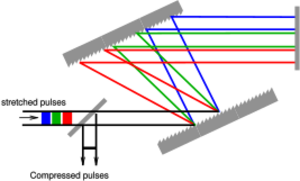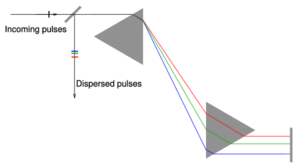Chirped pulse amplification facts for kids
Chirped pulse amplification (CPA) is a clever way to make laser pulses incredibly powerful. Imagine a tiny flash of light, super short and super bright. CPA takes this flash, stretches it out in time, makes it much stronger, and then squishes it back into a super short, super powerful flash. This method lets lasers reach amazing power levels, like those used in big science experiments.
This special laser technique was invented by Donna Strickland and Gérard Mourou in the mid-1980s at the University of Rochester. Their amazing work earned them the Nobel Prize in Physics in 2018. Today, CPA is the most common method used in the world's most powerful lasers.
Contents
Why We Need CPA
Before CPA was invented in the 1980s, there was a big problem with making lasers more powerful. If a laser pulse became too strong, it would actually damage the parts of the laser itself! This happened because the intense light would cause strange effects, like the beam focusing too much on its own, which could ruin the laser. To avoid this, older laser systems had to be very big and expensive, and their power was limited.
CPA solved this problem. Here's how it works:
- First, a very short laser pulse is stretched out in time. Think of it like taking a short, fat sausage and stretching it into a long, thin string. Special tools called gratings are used for this. They make different colors (or frequencies) of the light travel different distances. This causes the pulse to become much longer, sometimes 1,000 to 100,000 times longer than it was originally.
- When the pulse is stretched, its power becomes much lower. This low-power, stretched pulse can then be safely made much stronger (amplified) without damaging the laser parts. It can be amplified a million times or more!
- Finally, the now super-strong, stretched pulse is squished back to its original short length. This is done using similar tools that stretched it. When it's squished back, all that amplified power is packed into a tiny moment, making the laser pulse incredibly powerful.
Because of CPA, lasers can now create much higher peak power than ever before. It also helps make powerful laser systems smaller. A compact, high-power laser, sometimes called a "tabletop terawatt laser," can be built using CPA. These lasers can deliver a lot of energy in a very short time.
How Lasers Stretch and Squish Light
To stretch and squish laser pulses, scientists use special optical tools. These tools change how fast different colors of light travel.
Using Gratings
One common way to stretch or squish light is by using gratings. A grating is a surface with many tiny, parallel lines. When light hits a grating, it spreads out into its different colors, much like a prism.
Figure 1 shows a simple setup with two gratings. The light travels different distances depending on its color. This setup is often used to squish the laser pulse back together. You can change how much it squishes by moving the gratings closer or farther apart.
Figure 2 shows a more complex setup that also uses gratings, but it includes lenses (or mirrors). This setup is usually used to stretch the laser pulse before it gets amplified. It's important for the laser beam to be very thin in this setup to avoid problems.
Using Prisms
Instead of gratings, you can also use prisms to stretch or squish laser pulses, as shown in Figure 3. Prisms also spread light into its different colors.
Prisms don't spread the light as much as gratings do for the same distance between them. Sometimes, prisms and gratings are even combined to get very precise control over the laser pulse.
What CPA Lasers Are Used For
CPA is used in almost all of the world's most powerful lasers. These lasers are used for many important scientific studies.
Some examples of these super powerful lasers include:
- The Vulcan laser in the UK.
- The Diocles laser in the US.
- The GEKKO XII laser in Japan.
- The OMEGA EP laser in the US.
Scientists are also looking into new ways to use CPA. For example, one idea is to use these powerful laser pulses to change highly radioactive materials. This could help reduce how long these dangerous materials stay radioactive, from thousands of years to just a few minutes.
Besides these giant research lasers, many companies also sell smaller, powerful CPA lasers. These lasers are used in various fields, from manufacturing to medical research.
See also
 In Spanish: Amplificación de pulso gorjeado para niños
In Spanish: Amplificación de pulso gorjeado para niños





